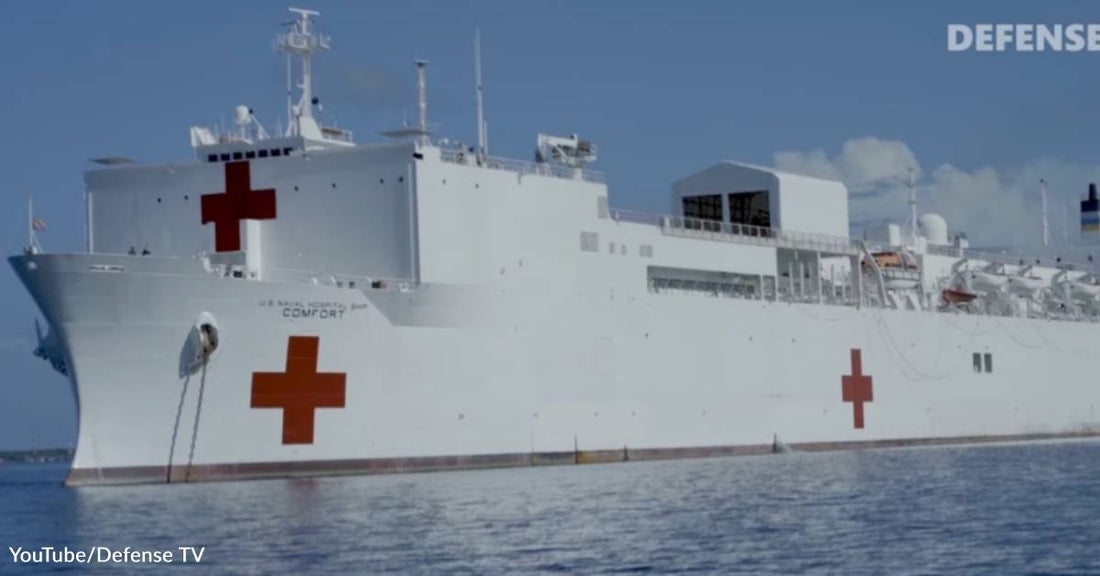About Our Modern U.S. Navy Hospital Ships
Dan Doyle
There are currently two active-duty U.S. Navy Hospital Ships. They are among the largest ships in the United States Navy; indeed, they are the third-largest ships, behind the Nimitz- and Ford-class aircraft carriers. Here are some interesting facts about these incredible U.S. Navy ships.
The two active Hospital Ships are the USNS Mercy and the USNS Comfort. Both are converted oil ships that have been made into highly mobile and sophisticated hospitals, with all of the necessary equipment needed to care for patients. They are equivalent to the largest land-based hospitals in the country. They have 1000 hospital beds, including 80 intensive care unit beds. To give you a sense of proportion here, this is more hospital beds and more intensive care unit beds than there are in the whole state of Maine.
 Photo: YouTube/Defense TV
Photo: YouTube/Defense TVBecause of the intended purpose of these ships, they were given a protected status when the Geneva Convention accords were written in 1949. The Geneva Convention Accord said that hospital ships had to be painted white with a red cross, that they were to be specifically and solely for the care of the wounded and sick, and that, because of this, they could not carry any ammunition or weapons. This was all intended to make the hospital ships of any nation identifiable and protected. They were not to be fired upon or attacked.
The USNS Mercy is homeported in New York Harbor, and the USNS Comfort is homeported in Los Angeles. Both are intended for the care of trauma patients, not for things like pandemic, though they were refitted to be able to care for Coronavirus patients during the pandemic, you might recall. They were deployed at that time to help care for any patient overflows from the local hospitals that were being overwhelmed at the height of the pandemic. But their main medical training, equipment, and function is for the care of the traumatic wounds of war.
 Photo: YouTube/Defense TV
Photo: YouTube/Defense TVBoth the Mercy and the Comfort were deployed most recently during Desert Shield and Desert Storm operations. Currently, the USNS Mercy operates in the Pacific region. It has been regularly deployed to help out with humanitarian and natural disaster situations in that area.
The USNS Comfort was first deployed in 1992 in Desert Storm and then to an earthquake disaster in Haiti. She was deployed in 2003 in support of the Iraq Invasion. She also deployed to NYC in response to the 9/11 attacks. She later provided humanitarian and medical aid for the victims of Hurricane Katrina in New Orleans.
 Photo: YouTube/Defense TV
Photo: YouTube/Defense TVIn my time, during the Vietnam War, there were two hospital ships offshore that took care of thousands of our wounded and sick. They were the USNS Repose and USNS Sanctuary. I had my own experience on the USNS Sanctuary when I was knocked out of commission by a bad case of malaria. I was myself a Hospital Corpsman attached to Bravo Co. 3rd Recon Bn., 3rd Mar. Div. at the time. One evening, while in the rear after a series of patrols with my team, I became ill and reported to the 3rd Recon Bn. sick bay in Quang Tri with fever and chills. I had a temperature of 105 degrees. I apparently passed out, and the next thing I knew, I was waking up on the hospital ship USNS Sanctuary. I had been flown by helicopter out to the ship and had no memory of the trip. I spent 21 days on the ship being treated for and recovering from my malaria. The care, the environment aboard ship in the malaria ward, felt like you were really in a modern hospital. The nurses, Corpsmen, and the doctors, were the best, and the care was of the highest quality. The irony, though, is that they healed me so well that I was sent back to my Recon unit for another four months of patrols before I was transferred to serve my last month in-country at Charlie Med in Quang Tri.
 Photo: YouTube/Defense TV
Photo: YouTube/Defense TVThese U.S. Navy Hospital Ships are incredibly valuable in their wartime capabilities but even more now in their abilities to bring expert medical care and support to humanitarian and natural disaster situations around the world. The Corpsmen, nurses, and doctors who are the core of these ships' purposes are highly trained professionals who have seen it all. There are countless numbers of military personnel and veterans who can say that they owe their lives to the medical care they received on these ships.
Honor and respect to the crews and the medical staff that crew these awesome U.S. Navy Hospital Ships. We wish you all Fair Winds and Following Seas!
https://www.youtube.com/watch?v=JZNoTMTgYpY


